Indonesia - South East Asia

Indonesia facts & history in brief
Jakarta
EXcerpted from Wikipedia, the free encyclopedia.
Jakarta
Daerah Khusus Ibukota Jakarta
Special Capital Territory of Jakarta
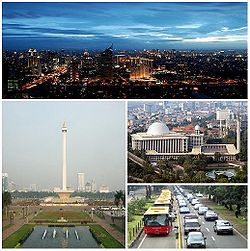 Jakarta Skyline (top), Monumen Nasional (left),
Jakarta Skyline (top), Monumen Nasional (left),
Istiqlal Mosque (center right),
and Jakarta traffic

Seal
Nickname(s): The Big Durian
Motto: Jaya Raya (Indonesian)
(Victorious and Great)
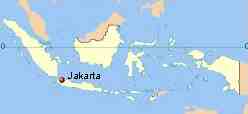
Location of Jakarta
Coordinates: 6°16'S 106°48'E
Country: Indonesia
Province: Jakarta
Government - Type:
Special administrative area
Area: - City 656 km² (253.3 sq mi)
Elevation: 4 m (13 ft)
Population: (2008) 8,500,000
- City 8,500,000
- Density 12,957.31/km² (33,559.3/sq mi)
- Metro 24,094,000
Time zone: WIB (UTC+7)
Area code(s): +6221
Website: www.jakarta.go.id
Jakarta (also DKI Jakarta) is the capital and largest
city of Indonesia.
It is the largest city by population in Indonesia and
in Southeast Asia as a whole.
It was formerly known as Sunda Kelapa (397–1527),
Jayakarta (1527–1619), Batavia (1619–1942), and
Djakarta (1942–1972).
Located on the northwest coast of Java, it has an
area of 661.52 square kilometres (255.41 sq mi) and
a population of 8,489,910.
Jakarta is the country's economic, cultural and
political center. Jakarta is the twelfth-largest
city in the world; the metropolitan area, called
Jabodetabek, is now the second largest
in the world.
First established in the fourth century, the city
became an important trading port for the Kingdom
of Sunda.
As Batavia, it grew greatly as the capital of the
colonial Dutch East Indies.
Renamed Jakarta in 1942 during Japan's occupation
of Java, it was made the capital city of Indonesia
when the country became independent after
World War II.
Major landmarks in Jakarta include Indonesia Stock Exchange,
the Bank of Indonesia, and the National Monument
(Tugu Monas).
The city is the seat of the ASEAN Secretariat.
Jakarta is served by the Soekarno-Hatta International
Airport, Halim Perdanakusuma International Airport,
and Tanjung Priok harbour; it is connected by several
intercity and commuter railways, and served by several
bus lines running on reserved busways.
Geography
Jakarta is located on the northwestern coast of Java,
at the mouth of the Ciliwung River on Jakarta Bay, which
is an inlet of the Java Sea.
The northern part of Jakarta is constituted on a plain
land, approximately eight meters above the sea level.
This contributes to the frequent flooding.
The southern parts of the city are hilly.
There are about thirteen rivers flowing through Jakarta,
mostly flowing from the hilly southern parts of the city
northwards towards the Java Sea.
The most important river is the Ciliwung River, which
divides the city into the western and eastern
principalities.
The city border is the province of West Java on its east
side and the province of Banten on its west side.
The Thousand Islands, which are administratively a part of
Jakarta, are located in Jakarta Bay north of the
city.
Climate
Jakarta has a hot and humid equatorial/tropical climate
(Af) according to the Köppen climate classification
system.
Located in the western-part of Indonesia, Jakarta's wet
season rainfall peak is January with average monthly
rainfall of 400 millimetres (16 in), and its dry season
low point is August with a monthly average of 70 millimetres
(2.8 in).
The city is humid throughout the year with daily temperature
range of 25° to 36°C (77°-97°F).
History
The old name of Jakarta was Sunda Kelapa.
The earliest record mentioning this area as a capital city
can be traced to the Indianised kingdom of Tarumanagara as
early as the fourth century.
In AD 39, King Purnawarman established Sunda Pura as a new
capital city for the kingdom, located at the northern coast
of Java.
Purnawarman left seven memorial stones with inscriptions
bearing his name spread across the area, including the
present-day Banten and West Java provinces.
The Tugu Inscription is considered the oldest of all of
them.
After the power of Tarumanagara declined, all of its many
territories, including Sunda Pura, became part of the
Kingdom of Sunda.
The harbour area were renamed Sunda Kelapa as written in
a Hindu monk's lontar manuscripts, which are now located
at the Bodleian Library of Oxford University in England,
and travel records by Prince Bujangga Manik.
By the fourteenth century, Sunda Kelapa became a major
trading port for the kingdom.
The first European fleet, four Portuguese ships from Malacca,
arrived in 1513 when the Portuguese were looking for a route
for spices, especially black pepper.
The Kingdom of Sunda made a peace agreement with Portugal
by allowing the Portuguese to build a port in 1522 in order
to defend against the rising power of the Sultanate of Demak
from central Java.
In 1527, Fatahillah, a Sumatran Malay warrior from Demak
attacked Kingdom of Sunda and succeeded in conquering the
harbour on June 22, 1527, after which Sunda Kelapa was renamed
Jayakarta.
Through the relationship with Prince Jayawikarta from the
Sultanate of Banten, Dutch ships arrived in Jayakarta in
1596.
In 1602, the British East India Company's first voyage,
commanded by Sir James Lancaster, arrived in Aceh and
sailed on to Banten where they were allowed to build a
trading post.
This site became the center of British trade in Indonesia
until 1682.
Apparently, Jayawikarta also made a trading connection with
the English merchants, rivals of the Dutch, by allowing them
to build houses directly across from the Dutch buildings in
1615.
When relations between Prince Jayawikarta and the Dutch
later deteriorated, Jayawikarta's soldiers attacked the
Dutch fortress.
But even with the help of fifteen British ships, Prince
Jayakarta's army wasn't able to defeat the Dutch, in
part owing to the timely arrival of Jan Pieterszoon Coen
(J.P. Coen).
The Dutch burned the English fort, and forced the English
retreat on their ships. With this victory, Dutch power in
the area was consolidated. In 1619 they renamed the city
"Batavia."
Commercial opportunities in the capital of the Dutch colony
attracted Indonesian and especially Chinese immigrants, the
increasing numbers creating burdens on the city.
Tensions grew as the colonial government tried to restrict
Chinese migration through deportations. On 9 October 1740,
5,000 Chinese were massacred and the following year, Chinese
inhabitants were moved to Glodok outside the city walls.
The city began to move further south as epidemics in 1835 and
1870 encouraged more people to move far south of the port.
The Koningsplein, now Merdeka Square was completed in 1818, the
housing park of Menteng was started in 1913, and Kebayoran Baru
was the last Dutch-built residential area.
By 1930 Batavia had more than 500,000 inhabitants, including
37,067 Europeans.
The city was renamed "Jakarta" by the Japanese during their World
War II occupation of Indonesia.
Following World War II, Indonesian Republicans withdrew from
allied-occupied Jakarta during their fight for Indonesian
independence and established their capital in Yogyakarta.
In 1950, once independence was secured, Jakarta was once again
made the national capital.
Indonesia's founding president, Sukarno, envisaged Jakarta as a
great international city.
He instigated large government-funded projects undertaken with
openly nationalistic and modernist architecture.
Projects in Jakarta included a clover-leaf highway, a major
boulevard (Jalan MH Thamrin-Sudirman), monuments such as The
National Monument, major hotels, shopping centre, and a new
parliament building.
In October 1965, Jakarta was the site of an abortive coup attempt
which saw 6 top generals killed, and ultimately resulted in the
downfall of Sukarno and the start of Suharto's "New Order.
A propaganda monument stands at the place where the general's bodies
were dumped.
In 1966, Jakarta was declared a "special capital city district"
(daerah khusus ibukota), thus gaining a status approximately
equivalent to that of a state or province.
Lieutenant General Ali Sadikin served as Governor from the mid-60's
commencement of the "New Order" through to 1977; he rehabilitated
roads and bridges, encouraged the arts, built several hospitals,
and a large number of new schools.
He also cleared out slum dwellers for new development projects—some
for the benefit of the Suharto family — and tried to eliminate
rickshaws and ban street vendors.
He began control of migration to the city in order to stem the
overcrowding and poverty.
Land redistribution, structural adjustment, and foreign investment
contributed to a real estate boom which changed the face of the
city.
The boom ended with the 1997/98 East Asian Economic crisis putting
Jakarta at the center of violence, protest, and political
maneuvering.
Long-time president, Suharto, began to lose his grip on power.
Tensions reached a peak in the Jakarta riots of May 1998, when four
students were shot dead at Trisakti University by security forces;
four days of riots and violence ensued resulting in the loss of an
estimated 1,200 lives and 6,000 buildings damaged or destroyed.
The Jakarta riots targeted many Chinese Indonesians.
Suharto resigned as president, and Jakarta has remained the focal
point of democratic change in Indonesia.
A number of Jemaah Islamiah-connected bombings have occurred in
the city since 2000.

Photos courtesy: Wikipedia, the free encyclopedia - Many thanks - Editor -
Click for an enlargement.
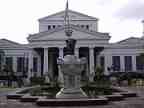 |
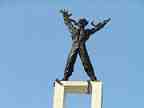 |
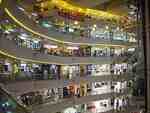 |
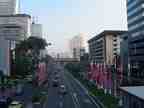 |
| National Museum of Indonesia |
Irian Barat Statue |
Shopping mall in Jakarta |
Jalan Thamrin |
 |
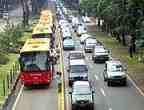 |
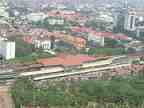 |
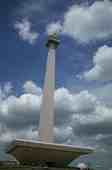 |
| Motorised bajaj |
TransJakarta bus service |
The elevated Gambir station |
The National Monument |


For more information about
Jakarta see Wikipedia, the free encyclopedia

This page was retrieved and condensed from
(http://en.wikipedia.org/wiki/Jakarta)
see Wikipedia, the free encyclopedia, November 2008.
All text is available under the terms of the
GNU Free Documentation License
(see
Copyrights for details).
About Wikipedia
Disclaimers

This information was correct in November 2008. E. & O.E.

Site Index
Back to Top
Photos Index
Thanks for coming, I hope you
have enjoyed it, will recommend
it to your friends, and will come
back later to see my site developing
and expanding.
I'm trying to make my pages
enjoyable and trouble free for everyone,
please let me know of any mistakes
or trouble with links, so I can
fix any problem as soon as possible.
These pages are best viewed with
monitor resolution set at
800x600 and kept simple on purpose so
everyone can enjoy them across all media and
platforms.
Thank you.
Webmaster

|












